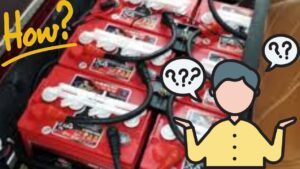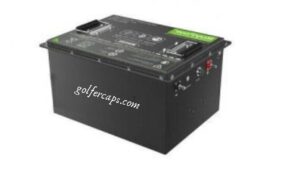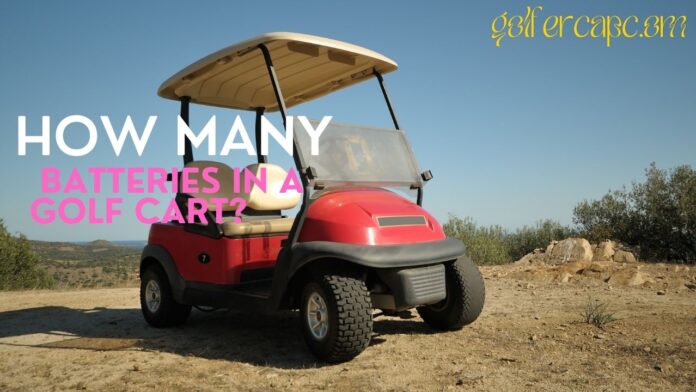Understanding the intricacies of your golf cart’s battery system can be quite the puzzle, especially if you’re new to the world of golf carts. In this article, we’ll dive deep into the topic of golf cart batteries, including how many you need, how to maintain them, and what to consider when replacing or upgrading them. Whether you’re a seasoned golf cart owner or just starting, this guide will equip you with all the knowledge you need to keep your cart running smoothly.
Overview of Golf Cart Batteries
Before we get into the nitty-gritty, let’s start with the basics. Golf cart batteries are the lifeblood of your golf cart. They provide the necessary power to propel the cart and operate its various electrical components. Most golf carts use deep-cycle batteries designed to deliver a steady amount of power over a long period, which is different from the quick burst of energy provided by car batteries.
How Many Batteries in a Golf Cart?

The number of batteries in a golf cart can vary from 4 to 12, depending on two key factors:
- System Voltage: Most golf carts run on either a 36-volt or 48-volt system.
- Individual Battery Voltage: These typically come in 6-volt, 8-volt, or 12-volt options.
Here’s a simplified breakdown:
- 36-volt system: Usually uses 6 6-volt batteries connected in series.
- 48-volt system: Can have configurations like:
- 4 12-volt batteries (common setup for simplicity)
- 6 8-volt batteries
- 8 6-volt batteries
Read also: How Long Does a Golf Cart Take to Charge?
Variations in Battery Numbers
The number of batteries in your golf cart will depend on the voltage of the batteries themselves.
- 6-Volt Batteries: Often found in both 36-volt and 48-volt systems.
- 8-Volt Batteries: Typically used in 48-volt systems for a more efficient power-to-weight ratio.
- 12-Volt Batteries: Also used in 48-volt systems but less common due to their larger size and weight.
Factors Influencing the Number of Batteries
Several factors can influence how many batteries your golf cart needs.
- Cart Model and Manufacturer: Different manufacturers might use different configurations even for similar voltage systems.
- Intended Use and Performance Needs: A cart used for longer distances or on more challenging terrain might require a different battery setup compared to a cart used only for short trips on flat surfaces.
- Battery Capacity and Range: Higher capacity batteries can provide a longer range but might require fewer individual batteries.
How to Determine the Number of Batteries in Your Golf Cart
To determine the number of batteries in your golf cart, start by checking the manufacturer’s specifications, usually found in the user manual or on the manufacturer’s website. You can also inspect the battery compartment to count the batteries and note their voltage. Additionally, consulting the user manual will provide detailed information on the battery configuration. This straightforward approach ensures you have accurate information tailored to your specific golf cart model.
Read also: Top 5 best ways how to clean white golf shoes
Maintenance of Golf Cart Batteries

Proper maintenance is key to extending the life and performance of your golf cart batteries. Here are five essential maintenance tips:
- Regular Cleaning: Keep the battery terminals and connections clean and free from corrosion. Use a mixture of baking soda and water to clean the terminals, then rinse with water and dry thoroughly.
- Check Water Levels: For lead-acid batteries, regularly check and maintain the water levels. Use distilled water to top off the cells, ensuring the plates are fully submerged but not overfilled.
- Inspect for Damage: Periodically inspect the batteries for any signs of physical damage, such as cracks, leaks, or bulging. Replace any damaged batteries immediately to prevent further issues.
- Proper Charging: Always use the appropriate charger for your golf cart batteries and follow the manufacturer’s guidelines. Avoid overcharging and ensure the batteries are fully charged after each use to prevent deep discharge.
- Regular Use: Use your golf cart regularly to keep the batteries active. If the cart is not in use for an extended period, periodically charge the batteries to maintain their health and prevent them from discharging completely.
Read also: Can You Wear Golf Shoes Casually?
Replacing Golf Cart Batteries
Replacing golf cart batteries is a necessary task that ensures your golf cart remains reliable and efficient. Here’s a quick guide to help you through the process:
- Signs Your Batteries Need Replacement: If you notice decreased range, longer charging times, or visible damage such as swelling or leaks, it’s likely time to replace your batteries.
- Choosing the Right Replacement Batteries: Ensure the replacement batteries match the specifications of your golf cart. Check the voltage and capacity requirements and consider the type of battery (lead-acid or lithium-ion) that best suits your needs.
- Step-by-Step Replacement Guide:
- Safety First: Wear protective gloves and eyewear. Turn off the golf cart and disconnect it from the charger.
- Remove Old Batteries: Disconnect the negative terminal first, followed by the positive terminal. Carefully remove the old batteries.
- Clean Battery Tray: Clean the battery tray and terminals with a mixture of baking soda and water to remove any corrosion.
- Install New Batteries: Place the new batteries in the tray. Connect the positive terminals first, followed by the negative terminals. Ensure all connections are tight and secure.
- Test the Installation: Turn on the golf cart and test it to ensure the new batteries are working properly.
- Disposing of Old Batteries: Properly dispose of the old batteries at a recycling center. Many places offer battery recycling services, which help protect the environment.
- Post-Replacement Care: After installing the new batteries, follow proper maintenance practices to ensure they last as long as possible. Regularly check water levels (for lead-acid batteries), clean terminals, and charge the batteries after each use.
Upgrading Golf Cart Batteries

Cost of Golf Cart Batteries
Olf cart battery costs depend on the type you choose:
- Lead-acid (most common): Affordable ($500-$800 for a set) but shorter lifespan.
- Lithium-ion (longer lasting): More expensive ($1000-$3000 for a set) but can save money in the long run due to durability.
Extending the Life of Your Golf Cart Batteries
To extend the life of your golf cart batteries, follow these key practices:
- Proper Charging: Always charge your batteries after each use and avoid deep discharges. Use the right charger and follow the manufacturer’s guidelines.
- Regular Cleaning: Keep the battery terminals and connections clean from corrosion using a mixture of baking soda and water.
- Water Levels: For lead-acid batteries, check and maintain the water levels regularly, using distilled water to top off as needed.
- Correct Storage: Store your golf cart in a cool, dry place and ensure the batteries are fully charged before long-term storage.
- Consistent Use: Regularly use your golf cart to keep the batteries active, and periodically charge them if the cart is not in use for extended periods.
Environmental Impact of Golf Cart Batteries
Conclusion
Understanding the number of batteries your golf cart needs, how to maintain them, and when to replace or upgrade them is essential for any golf cart owner. By following the tips and guidelines outlined in this article, you can ensure your golf cart runs smoothly and efficiently for years to come.
FAQs:
- How long do golf cart batteries typically last?
- Golf cart batteries usually last between 4 to 6 years, depending on usage and maintenance.
- Can I use car batteries in my golf cart?
- No, car batteries are not suitable for golf carts. Golf carts require deep-cycle batteries that can deliver steady power over a long period.
- What is the best way to store golf cart batteries during the off-season?
- Store your batteries in a cool, dry place and ensure they are fully charged before storing. Check and recharge them periodically during storage.
- How often should I charge my golf cart batteries?
- It’s best to charge your batteries after every use to ensure they remain fully charged and to avoid deep discharging.
- Are there any alternatives to traditional lead-acid batteries for golf carts?
- Yes, lithium-ion batteries are a popular alternative due to their longer lifespan, lighter weight, and better performance.










